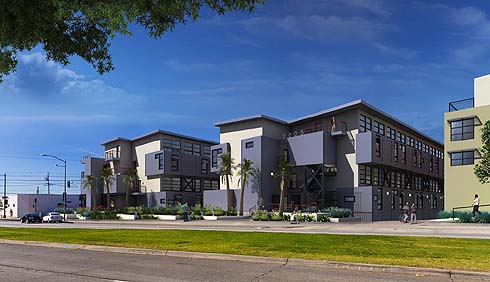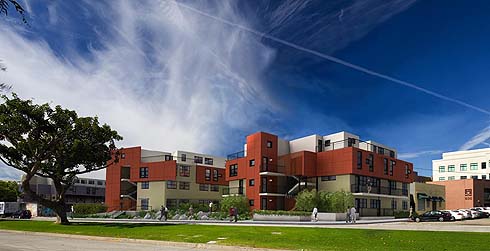|
By Olin Ericksen
Staff Writer
April 19 -- Perhaps the largest wave of housing
built by a single developer in recent history -- 1,150 studio
units renting for more than $1,000 a month -- could soon go
up in Santa Monica under a new law to encourage affordable
housing. Instead of putting out a welcome mat, though, city
officials are raising red flags.
While the five proposed buildings abide by the letter of
the new law, City officials worry they will bypass public
and environmental review, are not required to provide much
parking and open space and don’t address a critical
shortage of affordable family housing.
They also worry that the buildings, which take advantage
of height and density bonuses, may throw a wrench into plans
to redevelop Santa Monica’s light industrial corridor
under new zoning options being reviewed by the City.
 |
| Part of 623-unit SRO
slated to go up at 3025 Olympic Boulevard. (Renderings
courtesy of Killefer Flamang Architects) |
In an effort to address the issue, the City Council this
month unanimously voted to rush a staff report that could
serve as the basis for an emergency ordinance to toughen oversight
of large-scale single-room occupancy (SRO) projects.
"The concept was for staff to study this and come back
to us as an emergency ordinance, because I think we need to
look at this," said Council member Herb Katz, who, with
Bob Holbrook, made the motion on April 10 to return with the
staff report next Tuesday.
The largest of five such projects slated to be built by private
developer Neil Shehkter and his company NMS Properties would
stand four stories and contain 623 units at prices defined
as "affordable," but which will rent for between
$1,000 and $1,200 a month.
If approved, the massive development would replace a hodge-podge
of artists spaces, classrooms and production studios at 3025
Olympic Boulevard. Known as Drescherville for its eccentric
former owner, philanthropist John Drescher, the sprawling
property switched owners in a reported $27 million deal last
month.
"We want families," said Katz, noting that the
maximum occupancy in the residences is two people. "Obviously
we want affordable housing, but we want it done properly and
within scale."
The remaining 300 to 400-square-foot units would be spread
among four other projects, including two more on Olympic Boulevard
near 20th Street and two on Broadway near Lincoln Boulevard,
according to Killefer Flammang Architects, the firm that designed
all five projects.
The architects and Shehkter followed all the rules, all parties
agree.
Yet council members said these projects -- and perhaps more
to follow -- may not be what they intended last October when
they approved the new law in an effort to head off a controversial
state proposition that would have impacted the power of cities
to dictate development. (see
story)
"The fact that it slipped through the cracks and nobody
thought about it… doesn't mean we shouldn't take another
look," Katz said.
Intended to halt the onslaught of demolitions for condominium
developments and to encourage the building of new affordable
housing, the new law offer a host of incentives to developers
to build rental stock considered affordable under County rates
set annually by the State.
"We wanted to find a place and make it pencil out…
based on the latest laws where they were actually giving incentives
to developers to do a project like that,” said Shehkter,
who own NMS properties. "So that's exactly what we put
together."
Affordable builders, such as Shehkter, can not only bypass
lengthy public permit and environmental impact reviews under
the new law, but build as much as a third more square footage
and add ten feet onto the projects.
"The whole idea came from the units we already manage
and the huge need for affordable housing in the city,"
said Shehkter, who said his company already manages 234 units
in Santa Monica.
 |
| Another part of Olympic
project. |
In addition to a lack of public oversight and the increased
size, projects like Shehkter's would also only need to build
one-quarter of a parking space per unit, would lack firm mandates
on reserving livable open space and offer none of the coveted
ground floor retail planners say helps keep housing vibrant.
"So there are open space, parking, and -- because they
do not go through the development review process -- things
we are hearing we want from the community, these things would
not apply," said Planning Director Eileen Fogarty, who
testified on the item at the April 10 meeting.
While Shehkter said he will provide a parking space for every
unit and reserve as much as 63 percent of the largest project
for landscaping, council members worry other developers may
not go that route.
As to who would live in the units, architect Wade Killefer
said he envisioned students from Santa Monica College or "young
professionals" moving in.
"They are all rental, none of them for sale," he
said "It could be a market for students and young architects."
While the apartments may seem "pricey," the units
would allow someone from his firm to live in Santa Monica,
he jokingly told the council.
"What I have to pay people these days, they can afford
it," said Killefer, whose firm designed other affordable
housing built in the city by the non-profit, Community Corporation.
In addition to students and young professionals, Shehkter
said his apartments would be willing to accept the poor and
homeless given federal vouchers, but who cannot find landlords
willing to accept them.
"The Section 8 people call us all the time for affordable
housing and we don't have enough to give them," he said.
"There was especially a need for single-unit apartments
because there are a lot of people who come off the shelter-plus-care
and programs similar to that who are looking for those types
of units."
City officials, however, said other issues that would need
to be addressed include how such developments, in the heart
of the City's only remaining light industrial zone, may impact
future land use in that area -- which has been suggested as
a potential location for artists' lofts and studios.
It also comes at time when the City is updating the Land
Use and Circulation Elements of its General Plan, which will
dictate development in Santa Monica for the next two decades.
Still, Killefer said his firm has followed all the rules
and is addressing the City's declared needs in a way that
allows his clients to make a profit.
"The biggest problem the City has is not enough affordable
housing, and we are building a lot of affordable housing,"
he said. "Our projects are 100 percent affordable, which
is very much a part of City goals for affordable housing.
“We're building small units, but we are building a
lot of them and they are going to be affordable."
|